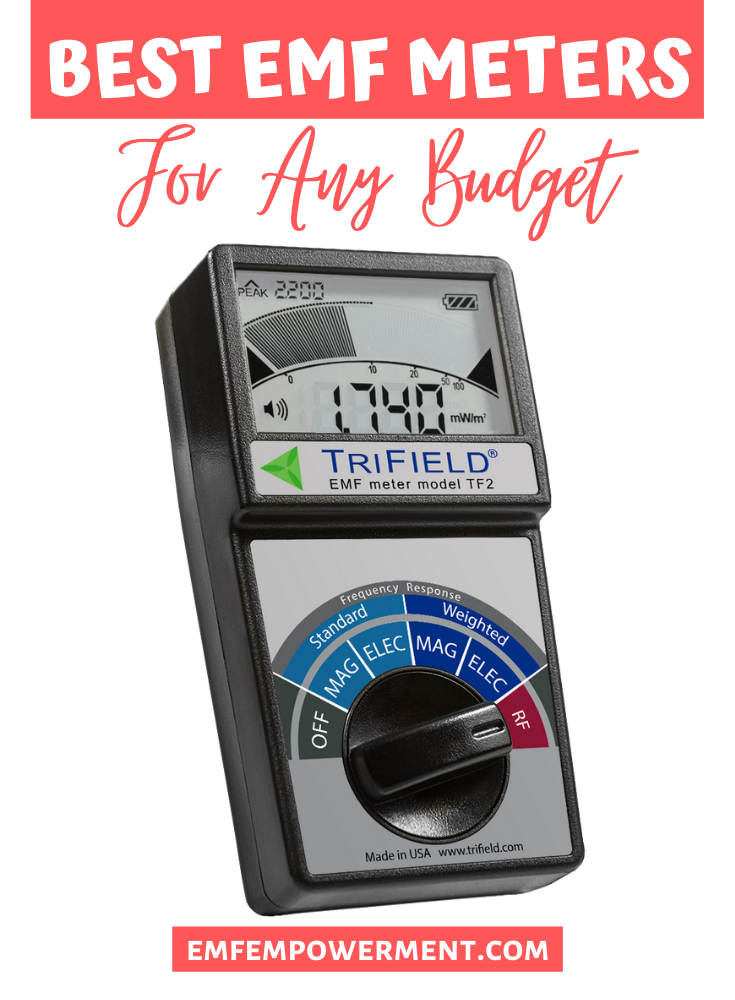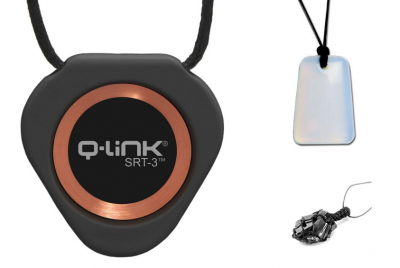When worn correctly, both Bluetooth and wired earbuds offer a lightweight and comfortable way to listen…
The Best EMF Meters For Any Budget

*We may earn a commission for purchases made using our links. Please see our disclosure to learn more.
In the morning, you’re woken up by your cell phone alarm. You check your email before you’ve gotten out of bed. You might even start the coffee pot with an app. If you’re like many Americans, you live an “always-on” life, constantly surrounded by electricity, WiFi, and Bluetooth. And while this level of connectedness is certainly convenient, it turns out that it may come at a price.
Your cell phone, smartwatch, laptop, TV, and other electric devices in your home emit electric and magnetic fields (EMFs). These EMFs are virtually everywhere, and it turns out that they may be wreaking havoc on your health. Some exposure to EMFs is unavoidable in modern society, but there are reasonable steps you can take to reduce your home’s levels and minimize your health risks.
The first thing to do to protect your family from EMF radiation is to find out how much is present in your home. To do this, you need an EMF meter. These devices measure the amount of EMF radiation present in the atmosphere and allow you to pinpoint which items in your home are producing the most radiation.
This article will explain what, exactly, EMFs are, break down the health risks associated with EMF radiation, recommend the best EMF meters for any budget, and explain how you can use your EMF meter to reduce your home’s levels.
What are electric and magnetic frequencies (EMFs)?
EFMs are waves produced by electric and magnetic fields. They are given off by anything electric, from your appliances to your phone.
Extremely Low Frequency (ELF) EMFs are given off by electricity, including from power lines. These are generally 60Hz. ELF EMFs are not very powerful, but we are exposed to them in cumulatively high doses. Radiofrequency (RF) EMFs, on the other hand, are a higher frequency — ranging from 100KHz on the low end to dozens of gigahertz on the high end. RF EMFs are more powerful than ELF EMFs, and our exposure to them has grown in the past 20 years as cell phones and the internet have become a part of daily life.
The government has set exposure limits to both ELF and RF-EMFs. Additionally, the World Health Organization’s International Agency for Research on Cancer has deemed both forms of EMF as potentially carcinogenic.
Risks of exposure
Power line (ELF) EMF exposure in high doses has been linked to childhood leukemia by numerous studies. Researchers noted that children living near high voltage power lines were more likely to develop childhood leukemia, in spite of the fact that non-ionizing radiation is considered safe.
RF-EMFs carry with them significant health risks, as well. Glioblastoma, a rare and aggressive form of brain cancer, has been associated with cell phone use. Many men experience problems with sperm count and motility as a result of storing their cell phones in their pockets. And an increase in tumor growth has also been associated with long-term exposure to RF-EMF radiation.
General EMF exposure is thought to be linked to depression, fatigue, anxiety, headaches, insomnia, and other common health complaints.
Recommended EMF Meters
If you’re concerned, know that there are steps you can take to protect yourself. The first thing you’ll need is a device that can measure EMF output. Some devices can measure both electric and magnetic waves, while others can only measure one. Likewise, some can measure ELF and RF-EMF radiation, while others can only measure certain frequencies. Ultimately, the right meter for you depends on what devices you plan to measure, and your budget.
With that in mind, we’ve created a list of the best EMF meters out there today. There are dozens of EMF meters on the market, and we’ve combed through all the reviews to handpick the best. If you’re looking for an EMF meter for your home, you’ll want to keep reading.
Best budget meter: AZX EMF Meter
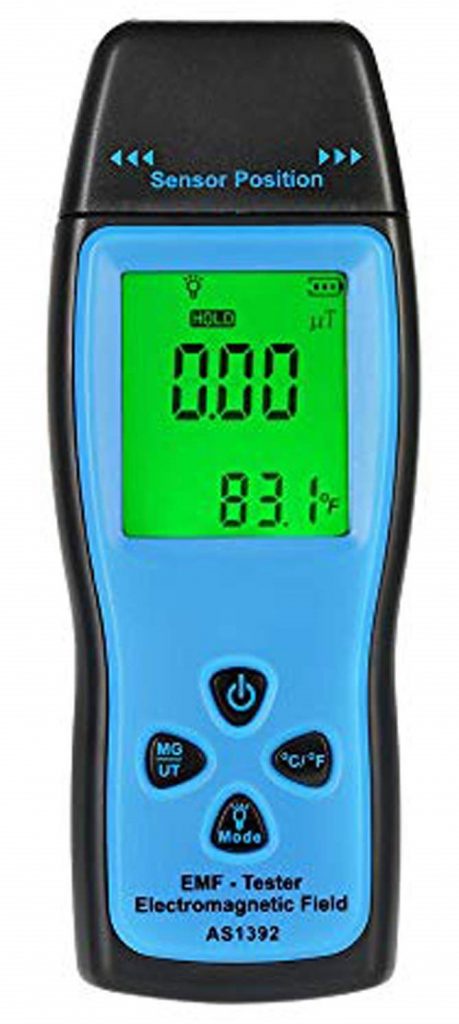
>> Check current price on Amazon
If you’re on a tight budget, it can be difficult to justify purchasing an EMF detector. You want to keep your family safe, but the high-end EMF meters out there are an expensive initial investment. Fortunately, there’s AZX’s EMF Meter, a budget-friendly option that can get the job done. This meter can detect an impressive range of frequencies for a budget meter, allowing you to monitor both ELF and RF radiation. With an LCD backlight display, high sensitivity readings, and a durable case, this is a quality EMF meter suitable for anyone.
The AZX EMF Meter can detect both electric and magnetic frequencies. Its accuracy at lower frequencies may be questionable, but overall its values at higher frequencies were similar to much higher-end emf meters. At a price point that low, sacrificing some accuracy may be worth it. At the very least, the AZX meter was able to detect when it was near microwaves and other sources of EMF radiation.
Runner up: Erickhill Digital EMF Meter
>> Check current price on Amazon
Erickhill’s Digital EMF Meter is another great option for anyone looking to buy an EMF meter on a budget. It offers precise measurements within the extremely low-frequency range, allowing users to detect levels of electric and magnetic field radiation. The device features a sound-light alarm, as well, that notifies of levels in unsafe ranges with both visual and audio cues.
Erickhill’s EMF meter is a great option if you only need to test for extremely low frequencies. It cannot detect radio frequencies, which does make the device a bit less versatile than other meters on the market.
Best moderate meter: Poniie Rechargeable Digital EMF Meter
>> Check current price on Amazon
Poniie’s Digital EMF Meter is a durable option for anyone able to invest a little more into their meter. The backlit screen is easy to read and the device itself is highly user-friendly, with only six buttons. Poniie’s meter can detect frequencies from 50Hz to 8GHz, meaning you can detect ELF radiation as well as many radio frequencies.
Another useful feature is the histograph view. Using this, you can better identify a source of EMF radiation within an area. With high-end functionality and an intuitive design, Poniee’s Digital EMF Meter is worth considering.
Runner up: Latnex MG 300

>> Check current price on Amazon
Latnex’s MG 300 EMF Meter has many of the standard features you’d expect from a midrange EMF detector. With a detectable frequency range of 30Hz to 300 Hz, this meter can detect frequencies from power lines, air conditioning units, and other larger transmitters of EMF radiation. Similar to Meterk’s meter, the MG 300 cannot pick up cell phones or other RF-EMF frequencies.
The reason this device didn’t quite win the category is the price. It’s a bit pricey, especially for a meter that can’t detect RF frequencies. It is still a solid midrange option, however, and comes with a carrying case and an LCD display.
Best high-end meter: TriField EMF Meter Model TF2
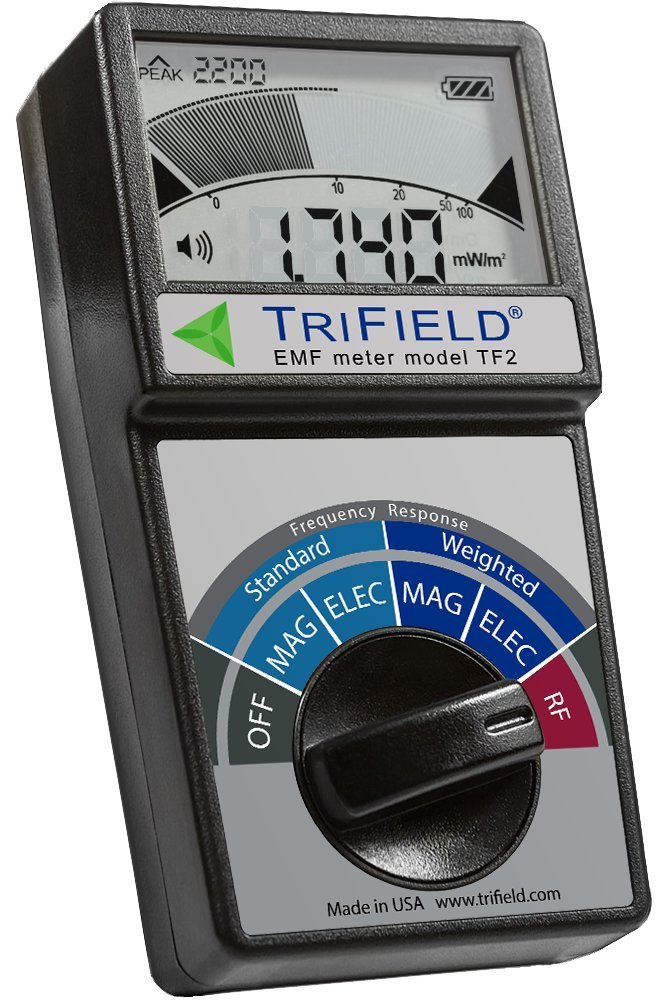
>> Check current price on Amazon
TF2 from TriField detects three kinds of radiation: magnetic, electric, and RF (microwave). This is a great option for anyone concerned about RF in addition to EMF radiation. TriField’s EMF meter detects an impressive range of frequencies for each type of radiation, allowing you to better home in on which devices in your home are putting your family at the most risk.
The TF2 offers almost instantaneous readings and is generally regarded as one of the more accurate devices on the market. With a detectable range of 40Hz to 100KHz, this can detect everything from power lines to cell phones and WiFi.
Runner up: Latnex HF-B3G
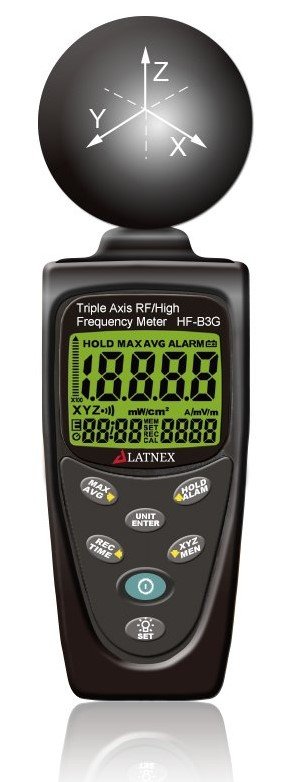
>> Check current price on Amazon
Latnex earns a second spot on this list with the HF-B3G. The HF-B3G is a solid, high-end meter worthy of consideration. Capable of detecting frequencies in the 50MHz to 3.5GHz range, this device is ideal for picking up radiation from a wide variety of devices, including wireless bugs and spy cameras. Unlike the TF2, however, the HG-B3G cannot detect ELF-EMF frequencies.
For that reason, the HF-B3G is better geared towards someone needing extreme RF-sensitivity, and who is less concerned with ELF-EMF radiation. Still, the easy-to-use interface and accurate readings warrant the device’s runner-up status.
Enjoying this Article? Be sure to Pin It on Pinterest!
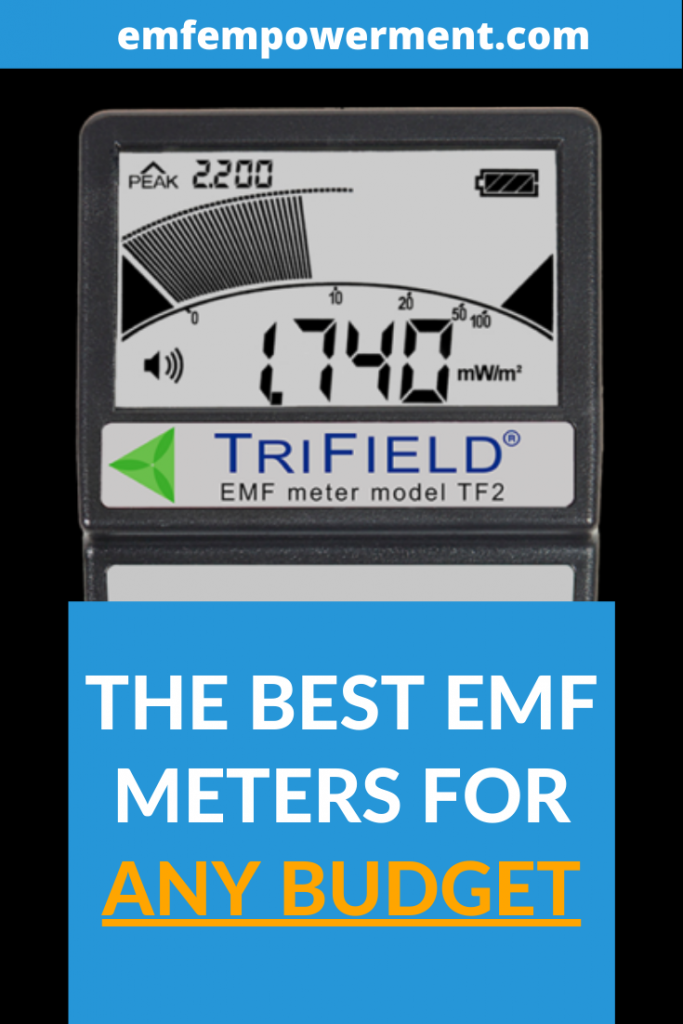
Using your EMF meter
Once you’ve purchased the best EMF meter for you, it’s time to put it to use. The goal of using an EMF meter is to detect the overall levels of radiation present in your home, as well as to gauge how much is coming from specific appliances and items. One of the best ways to track this is to create a spreadsheet for your entire household.
There are a variety of ways you can set the spreadsheet up — by item, for example, or by room. If you have a lot of electronics, it may be impractical to list them all. In that case, just track each room’s overall level, maybe even tracking the levels at different positions around the room. This allows you to hunt down which devices are putting out the most EMF, as well as to better design your rooms so that sitting areas and beds are away from atmospheric EMF.
EMF meter and spreadsheet in hand, go through your home and record the levels of radiation present. Once you have the results, it’s time to take action. Rearrange furniture, consider purchasing EMF guards for smart meters, and make other adjustments as necessary. Then, re-check your levels and see how they’ve changed.
If you can’t get the levels in your home down to an acceptable level because of proximity to power lines or other EMF-transmitters, consider going dark for a few hours each day, or each night. Shutting off the WiFi, powering down electronics, and reducing your EMF output as much as possible is one way to temporarily lower your family’s exposure. Doing this each day may help counteract some of the health risks associated with EMFs.
Conclusion
An EMF meter is an important item in your toolkit when it comes to protecting your family against EMF radiation. When it comes to meters, however, it’s difficult to find both accuracy and sensitivity to a wide range of frequencies. Lower-end models offer an impressive frequency range, one that in theory should allow the user to detect both ELF and RF-EMF radiation. In practice, however, it seems these devices are much better at detecting RF-EMF, and are generally less sensitive to lower frequencies. Midrange devices, on the other hand, offer a great deal of accuracy at the lower range, but they are simply not able to detect frequencies above 300Hz.
That all being said, if you can justify the expense, the higher-end EMF meters are worth the splurge. They offer both accuracy and sensitivity, allowing you to get the best picture of your home’s overall EMF levels. The features and increased reliability help make the higher-end models, particularly the Trifield TF2, worth the price.
At the end of the day, however, any meter is better than nothing. A fully charged budget model is still going to allow you to track down devices in your home that are putting off EMF radiation, even if it doesn’t offer the sensitivity and accuracy of a higher-end meter. Our list was designed to give you the information you need to make the best decision for your household, regardless of budget.
After purchasing your meter, it’s important to then use it to take action. Simply owning an EMF meter won’t keep your family safe. Rather, using it to track radiation levels in your home and then making changes based on your findings will allow you to reduce your family’s exposure to these harmful waves. 